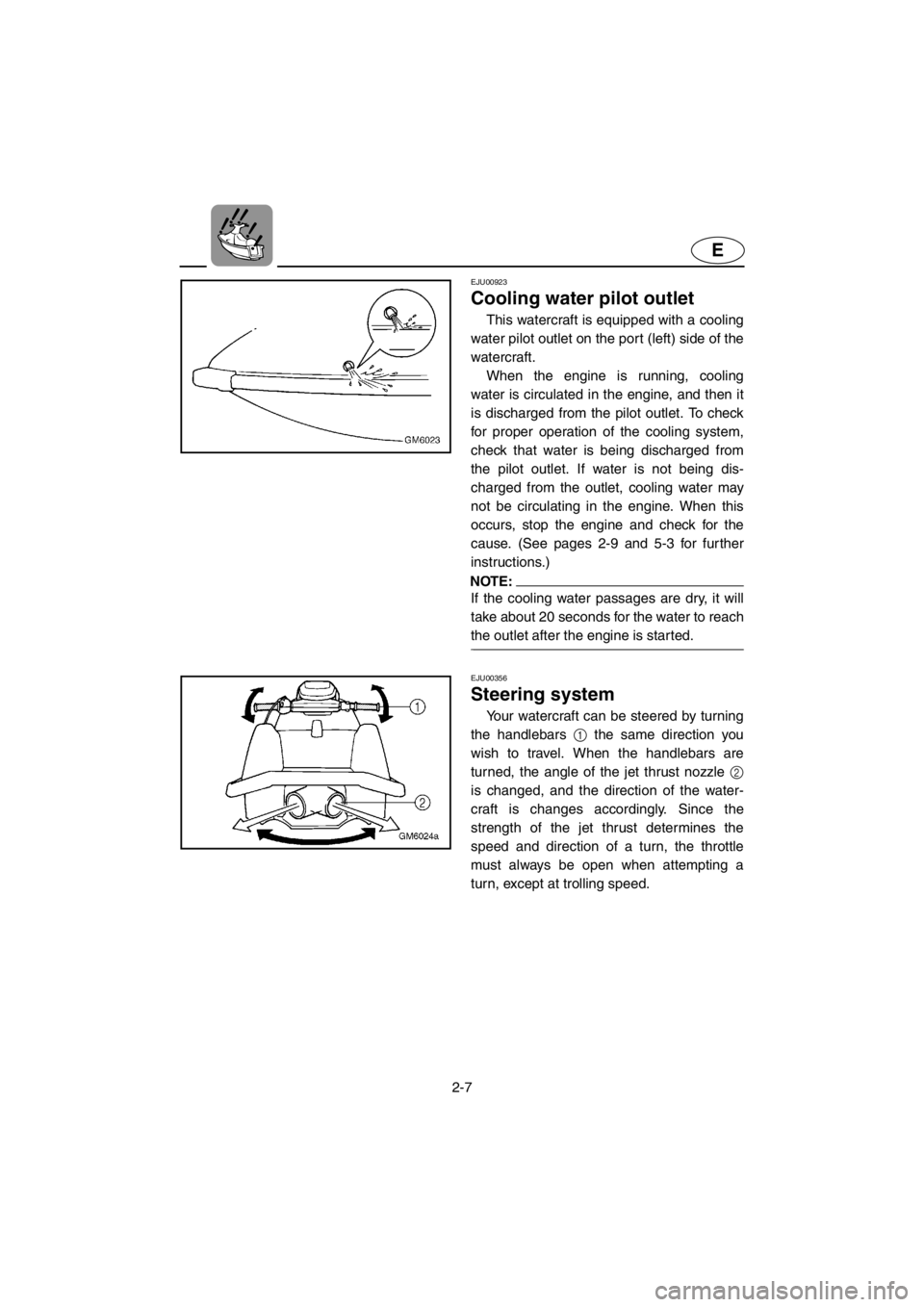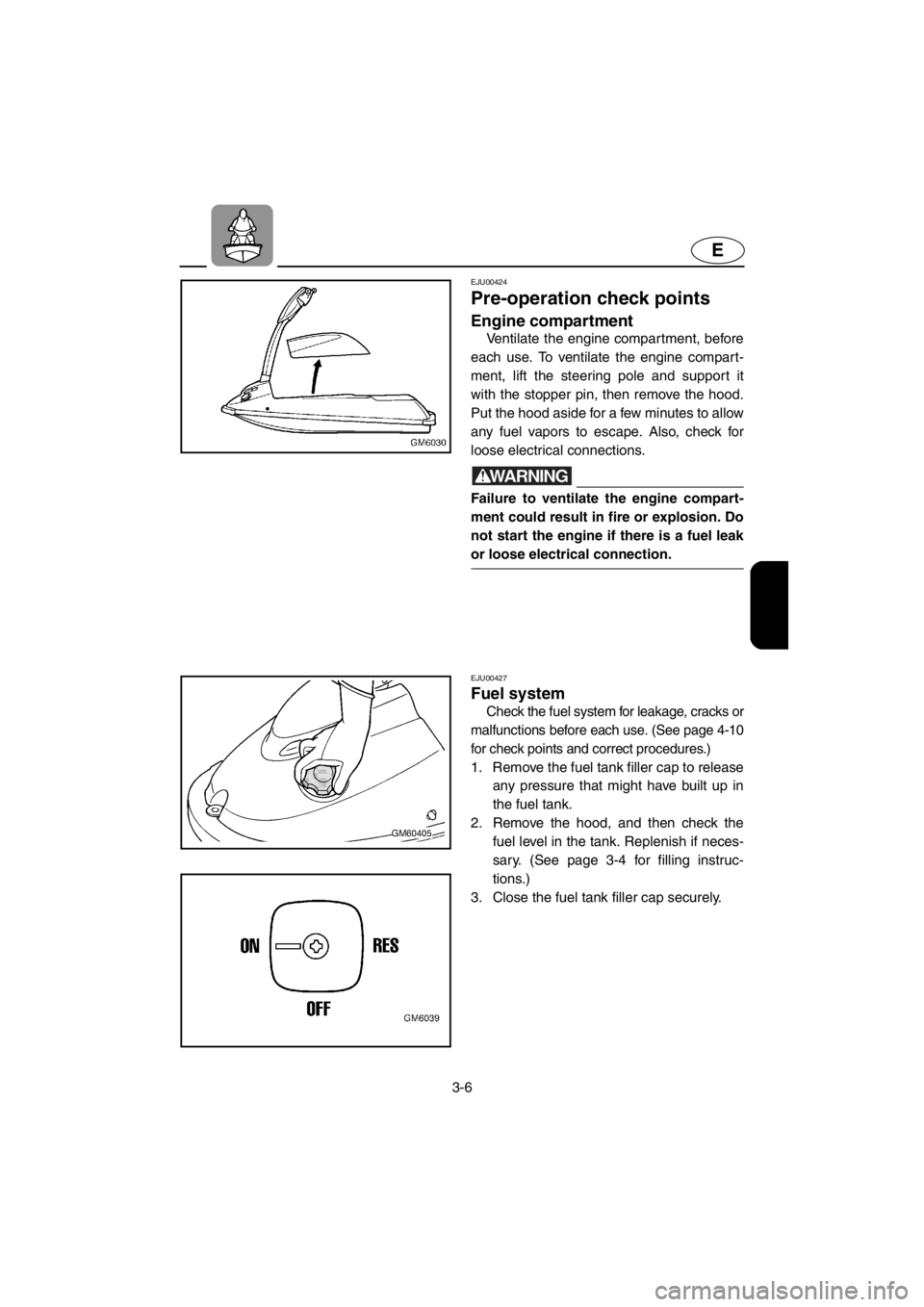check engine YAMAHA SUPERJET 2001 Owners Manual
[x] Cancel search | Manufacturer: YAMAHA, Model Year: 2001, Model line: SUPERJET, Model: YAMAHA SUPERJET 2001Pages: 107, PDF Size: 6.2 MB
Page 19 of 107

1-12
E
●Attach the engine shut-off cord (lanyard)
to wrist and keep it free from the handle-
bars so that the engine stops if the opera-
tor falls off. After riding, remove the
engine shut-off cord from the watercraft to
avoid accidental starting or unauthorized
use by children or others.
●Scan carefully for swimmers, and stay
away from swimming areas. Swimmers
are hard to see and you could acciden-
tally hit someone in the water.
●Avoid being hit by another boat! You
should always take the responsibility to
watch for traffic; other boaters may not be
watching for you. If they do not see you,
or you maneuver more quickly than other
boaters expect, you risk a collision.
●Maintain a safe distance from other boats
or watercraft, and also watch for boats’ ski
ropes or fishing lines. Obey the “Safe
boating rules” and be sure to check
behind you before making a turn. (See
Safe boating rules on page 1-14.)
EJU00313
Hazard information
●When transporting or storing your water-
craft, always place the fuel cock knob in
the “OFF” position, otherwise gasoline
may overflow from the carburetor.
●Never start the engine or let it run for any
length of time in an enclosed area.
Exhaust fumes contain carbon monoxide,
a colorless, odorless gas that may cause
loss of consciousness and death within a
short time. Always operate the watercraft
in an open area.
E_GM6-1.fm Page 12 Tuesday, July 11, 2000 10:49 AM
Page 30 of 107

2-7
E
EJU00923
Cooling water pilot outlet
This watercraft is equipped with a cooling
water pilot outlet on the port (left) side of the
watercraft.
When the engine is running, cooling
water is circulated in the engine, and then it
is discharged from the pilot outlet. To check
for proper operation of the cooling system,
check that water is being discharged from
the pilot outlet. If water is not being dis-
charged from the outlet, cooling water may
not be circulating in the engine. When this
occurs, stop the engine and check for the
cause. (See pages 2-9 and 5-3 for further
instructions.)
NOTE:@If the cooling water passages are dry, it will
take about 20 seconds for the water to reach
the outlet after the engine is started.
@
EJU00356
Steering system
Your watercraft can be steered by turning
the handlebars 1 the same direction you
wish to travel. When the handlebars are
turned, the angle of the jet thrust nozzle 2
is changed, and the direction of the water-
craft is changes accordingly. Since the
strength of the jet thrust determines the
speed and direction of a turn, the throttle
must always be open when attempting a
turn, except at trolling speed.
E_GM6-2.fm Page 7 Tuesday, July 11, 2000 10:51 AM
Page 32 of 107

2-9
E
EJU00943
Engine overheat warning
system
This model is equipped with an engine
overheat warning system. If the engine
starts to overheat, the engine speed will be
limited to about 3,000 r/min.
When this occurs, check for water dis-
charge at the cooling water pilot outlet. If
there is no discharge of water, reduce the
engine speed and beach the watercraft, and
then check the intake grate and impeller for
clogging.
WARNING@Before attempting to remove weeds or
debris from the intake grate or impeller,
shut the engine off and remove the clip
from the engine shut-off switch. Severe
injury or death could result from coming
in contact with the rotating parts of the
jet pump.
@
CAUTION:@If you cannot locate and correct the
cause of the overheating, consult a
Yamaha dealer. Continuing to operate at
higher speeds could result in severe
engine damage.
@
E_GM6-2.fm Page 9 Tuesday, July 11, 2000 10:51 AM
Page 35 of 107

E
3
EJU00410
OPERATION
Fuel and oil................................................ 3-1
Gasoline .................................................. 3-1
2-stroke engine oil................................... 3-2
Mixing fuel and oil .................................. 3-3
Filling the fuel tank .................................. 3-4
Pre-operation checks............................... 3-5
Pre-operation check list .......................... 3-5
Pre-operation check points..................... 3-6
Operation................................................. 3-13
Engine break-in ..................................... 3-13
Starting the engine................................ 3-15
Stopping the engine.............................. 3-18
Leaving the watercraft .......................... 3-18
Operating your watercraft..................... 3-19
Getting to know your watercraft............ 3-19
Learning to operate your watercraft ..... 3-19
Starting the watercraft........................... 3-21
Operating positions ............................... 3-25
Capsized watercraft .............................. 3-26
Turning the watercraft........................... 3-27
Stopping the watercraft......................... 3-29
Beaching the watercraft ........................ 3-30
Rough water operation ......................... 3-30
Post-operation checks.......................... 3-31
Transporting........................................... 3-33
E_GM6-3TOC.fm Page 1 Tuesday, July 11, 2000 10:51 AM
Page 40 of 107

3-5
E
EJU00422
Pre-operation checks
Pre-operation check list
Before operating this watercraft, perform the checks in the following check list. See the
accompanying text in this chapter for details on how to perform the checks.
WARNING@If any item in the pre-operation check list is not working properly, have it inspected
and repaired before operating the watercraft, otherwise an accident could occur.
@
NOTE:@Pre-operation checks should be made thoroughly each time the watercraft is used. This pro-
cedure can be completed in a short time. It is worth the time spent to assure safety and reli-
ability.
@
ITEM ROUTINE PAGE
Engine compar tment Remove hood, ventilate fuel vapors and check
electrical connections3-6
Bilge Check for water and fuel residue and remove if
necessary3-7
Throttle Check that throttle lever springs back 3-10
Steering system Check for proper steering system operation 3-10
Fuel Check fuel level and add if necessary
Check hoses and tank for leakage3-6
Water separator Check for water and drain if necessary 3-7
Battery Check electrolyte level and battery condition 3-8
Hood Check that hood latches are secured 2-3
Hull/Deck Check hull for cracks or other damage —
Jet unit Check for debris and remove if necessary 3-11
Fire extinguisher Check condition and replace if necessary 3-9
Engine shut-off cord Check condition and replace if frayed or broken 3-11
Switches Check start switch, engine stop switch and
engine shut-off switch for proper operation when
watercraft is in the water 3-12
Cooling water pilot outlet Check that water is discharged while engine is
running and watercraft is in the water3-12
E_GM6-3.fm Page 5 Tuesday, July 11, 2000 10:52 AM
Page 41 of 107

3-6
E
EJU00424
Pre-operation check points
Engine compartment
Ventilate the engine compartment, before
each use. To ventilate the engine compart-
ment, lift the steering pole and support it
with the stopper pin, then remove the hood.
Put the hood aside for a few minutes to allow
any fuel vapors to escape. Also, check for
loose electrical connections.
WARNING@Failure to ventilate the engine compart-
ment could result in fire or explosion. Do
not start the engine if there is a fuel leak
or loose electrical connection.
@
EJU00427
Fuel system
Check the fuel system for leakage, cracks or
malfunctions before each use. (See page 4-10
for check points and correct procedures.)
1. Remove the fuel tank filler cap to release
any pressure that might have built up in
the fuel tank.
2. Remove the hood, and then check the
fuel level in the tank. Replenish if neces-
sary. (See page 3-4 for filling instruc-
tions.)
3. Close the fuel tank filler cap securely.
E_GM6-3.fm Page 6 Tuesday, July 11, 2000 10:52 AM
Page 42 of 107

3-7
E
EJU00432
Water separator
Check the water separator 1 for water.
Normally the water separator is empty. The
water separator retains any water entering
through the fuel tank breather hose if the
watercraft capsizes.
If water remains in the water separator,
drain it by removing the drain screw 2.
Install the drain screw again after draining
the water separator.
EJU00941
Bilge
Check for moisture and fuel residue in the
bilge.
Excessive water in the bilge can splash
into the carburetor and engine which could
cause engine damage.
E_GM6-3.fm Page 7 Tuesday, July 11, 2000 10:52 AM
Page 43 of 107

3-8
E
EJU00435
Battery
Check the battery condition and the elec-
trolyte level. Check that the battery leads are
tightened securely and there is no corrosion
on the battery terminals.
WARNING@The battery must always be fully charged
and in good condition. Loss of battery
power may leave you stranded. Never
operate the watercraft if the battery does
not have sufficient power to start the
engine or if it shows any other signs of
decreased power.
@
Make sure that the breather hose is prop-
erly connected and that it is not damaged or
obstructed.
Make sure that the battery is securely
held in place.
1
Positive (+): Red lead
2
Negative (–): Black lead
3
Breather hose
E_GM6-3.fm Page 8 Tuesday, July 11, 2000 10:52 AM
Page 45 of 107

3-10
E
EJU00447
Throttle
Squeeze and release the throttle lever
several times to make sure that there is no
hesitation in its travel. It should be smooth
over the complete range, and spring back to
the idle position when released.
WARNING
Before starting the engine, always check
the operation of the throttle lever. It
should move smoothly through its full
range of operation, and should spring
back to the idle position when released.
EJU00448
Steering system
Check for looseness in the handlebars.
Turn them as far as possible to the right and
left to make sure that operation is smooth
and unrestricted throughout the whole
range. Make sure that the jet thrust nozzle
also changes directions as the handlebars
are turned, and that there is no free play
between the handlebars and the jet thrust
nozzle.
EJU00449
Steering pole
Check for looseness in the steering pole.
Move it up and down to make sure operation
is smooth and unrestricted throughout the
whole range. Make sure the steering pole
does not have any side play.
E_GM6-3.fm Page 10 Tuesday, July 11, 2000 10:52 AM
Page 46 of 107

3-11
E
EJU00942
Jet unit
Carefully check the jet intake for weeds,
debris, or anything else that might restrict
the intake of water. If the intake is clogged,
cavitation could occur, reducing jet thrust,
and possibly damaging the jet pump. In
some cases, the engine may overheat
because of lack of cooling water, and dam-
age to the engine could result. Engine cool-
ing water is fed to the engine by the jet
pump. (See page 5-3 for jet intake cleaning
procedures).
WARNING@●Keep away from intake grate while
engine is on. Items such as long hair,
loose clothing, or PFD straps can
become entangled in moving parts
resulting in severe injury or drowning.
●Stop the engine and remove the clip
from the engine shut-off switch before
removing any debris or weeds which
may have collected around the jet
intake.
@
EJU9001a
Engine shut-off cord (lanyard)
Check that the engine shut-off cord is not
frayed or broken. If the cord is damaged,
replace it; never try to repair it or tie it
together.
E_GM6-3.fm Page 11 Tuesday, July 11, 2000 10:52 AM